
e955 sweetener
The Sweet Solution Understanding E955 Sweetener
In today’s world, where health consciousness is on the rise, consumers are constantly seeking alternatives to sugar that do not compromise on taste. Among the myriad of sweeteners available in the market, E955, also known as sucralose, has emerged as a popular choice. This article delves into the nature, benefits, and potential concerns surrounding E955 sweetener and how it fits into the broader context of dietary choices.
What is E955?
E955, or sucralose, is a chlorinated derivative of sucrose. Its unique structure allows it to be several hundred times sweeter than regular sugar while containing minimal calories. Developed in 1976 and approved for use in food products by the U.S. Food and Drug Administration (FDA) in 1998, sucralose has since been widely used in various food and beverage products, including soft drinks, baked goods, and even candies.
The Benefits of E955
One of the primary advantages of E955 is its ability to satisfy the sweet tooth without the caloric contribution of sugar. For individuals looking to manage their weight or those diagnosed with diabetes, sucralose offers a viable alternative. It does not cause a spike in blood glucose levels, making it suitable for people who monitor their carbohydrate intake.
Additionally, sucralose has great heat stability, making it ideal for cooking and baking. This property allows it to retain its sweet flavor even when subjected to high temperatures, which is not the case for many other artificial sweeteners. Furthermore, since E955 is not metabolized by the body, it passes through the system unchanged, resulting in no energy contribution.
E955 in the Diet
e955 sweetener

As more food manufacturers utilize E955, its presence in everyday diets has increased. A quick glance at ingredient labels shows that sucralose is often added to products marketed as low-sugar, sugar-free, or diet. Soft drinks and yogurts are prime examples of items where E955 is commonly found. For people seeking to reduce sugar consumption while still enjoying sweet flavors, E955 offers a practical solution.
Potential Concerns
Despite its widespread use and acceptance, E955 is not without controversy. Some studies have raised questions about the long-term health effects of consuming artificial sweeteners. While regulatory bodies like the FDA, the European Food Safety Authority (EFSA), and the World Health Organization (WHO) recognize sucralose as safe for human consumption at established intake levels, public skepticism remains.
One of the main criticisms of E955 is its impact on gut health. Research indicates that artificial sweeteners, including sucralose, may alter gut microbiota composition. A balanced gut microbiome is crucial for overall health, and any disruption could potentially lead to metabolic disorders.
Moreover, there is a concern about sucralose’s effects on insulin sensitivity and appetite regulation. Some studies suggest that consuming artificial sweeteners may lead to increased cravings for sugary foods, counteracting the intended benefits of using E955 as a sugar substitute.
Conclusion
E955 sweetener, or sucralose, has undoubtedly changed the landscape of sweeteners available to consumers. Its ability to provide sweetness without caloric content aligns well with modern dietary trends geared towards health and wellness. However, as with any food additive, it is crucial for individuals to stay informed and consider their unique dietary needs and preferences.
Whether E955 is a welcome addition to your diet or one to be avoided, understanding its benefits and potential concerns is essential. Ultimately, moderation is key. By making informed choices and maintaining a balanced approach to nutrition, individuals can harness the benefits of E955 while mitigating any associated risks. As the conversation around artificial sweeteners continues to evolve, E955 remains a significant player in the quest for healthier sweetness.
-
Pure Sodium Dichloroisocyanurate Dihydrate | Powerful DisinfectantNewsAug.29,2025
-
Industrial Chemicals: Quality & Purity for Every IndustryNewsAug.28,2025
-
Nitrile Rubber Honoring Strict Production StandardsNewsAug.22,2025
-
Aspartame Ingredients Honoring Food Safety ValuesNewsAug.22,2025
-
Fertilizer for Balanced Plant NutritionNewsAug.22,2025
-
Cyanide Gold Processing with High Purity AdditivesNewsAug.22,2025
-
Formic Acid in Textile Dyeing ApplicationsNewsAug.22,2025
Hebei Tenger Chemical Technology Co., Ltd. focuses on the chemical industry and is committed to the export service of chemical raw materials.
-

view more DiethanolisopropanolamineIn the ever-growing field of chemical solutions, diethanolisopropanolamine (DEIPA) stands out as a versatile and important compound. Due to its unique chemical structure and properties, DEIPA is of interest to various industries including construction, personal care, and agriculture. -

view more TriisopropanolamineTriisopropanolamine (TIPA) alkanol amine substance, is a kind of alcohol amine compound with amino and alcohol hydroxyl, and because of its molecules contains both amino and hydroxyl. -

view more Tetramethyl Thiuram DisulfideTetramethyl thiuram disulfide, also known as TMTD, is a white to light-yellow powder with a distinct sulfur-like odor. It is soluble in organic solvents such as benzene, acetone, and ethyl acetate, making it highly versatile for use in different formulations. TMTD is known for its excellent vulcanization acceleration properties, which makes it a key ingredient in the production of rubber products. Additionally, it acts as an effective fungicide and bactericide, making it valuable in agricultural applications. Its high purity and stability ensure consistent performance, making it a preferred choice for manufacturers across various industries.





